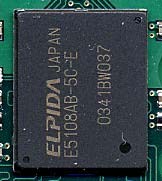FIRST LOOK: Kingston DDR2 Next-Generation Memory
by Wesley Fink on March 18, 2004 9:30 PM EST- Posted in
- Memory
Memory Chips: Kingston DDR2 Memory
Another major difference in DDR2 is the use of FBGA (Fine Ball Grid Array) memory chips instead of the current TSOP package.
We recently reviewed Kingmax DDR memory, which uses BGA memory chips, but every other DDR memory that we have tested uses TSOP chips. FBGA offers the same advantages as BGA with shorter traces/better signal integrity, thinner packaging, and better heat dissipation/cooler operation. FBGA just increases the density of the connections.

Kingston uses Elpida FBGA chips in their DDR2-533 modules.
Since the same chips can apparently be used in any DDR533 configuration from 256MB to 1GB per DIMM, then pricing and demand will certainly determine what you will see in the market. Kingston Data Sheets state that DIMMs up to 4GB will be available in DDR2. We expect to see 1GB DIMMs rather quickly, but 4GB DIMMs will only come when higher density FBGA chips become available. One of the potential advantages of DDR2 is certainly the greater capacity of DDR2 DIMMs, allowing more memory in fewer DIMM slots.










7 Comments
View All Comments
Pumpkinierre - Friday, March 19, 2004 - link
With the hot, possibly speed limited (where's that 3.4?) Prescott and double cost slower memory not forgetting PCI-E costs and problems, looks like intel may have got themselves another rambus/willamette scenario. With dual channel Sckt939 newcastle, nF3-250 fron nVidia and DDR1-550 coming from Hynix, lets hope AMD can profit this time.PrinceGaz - Friday, March 19, 2004 - link
Although initially its sure to be both more expensive and provide little if any performance benefit over standard DDR, its clear that pairing up a bandwidth-hungry P4 processor with DDR2 memory will become the norm within a year and we'll be looking at DDR only mobos for them by then in much the same way as we considered PC100/PC133 SDRAM ones a couple of years ago.Its more interesting where this will leave AMD and its Athlon 64 -- presumably they need to redesign the processor to support a new faster memory-standard and that probably isn't even possible without changing the current Socket 754/939/940 to something new. Though Socket 939 isn't even here yet. While the Athlon design isn't as sensitive to memory-bandwidth as the P4, sooner or later (probably later) its sure to switch which is going to leave existing A64 owners in a dead-end. But in the meantime AMD customers should benefit from cheaper memory as well as the cheaper mobos they're used to.
IamTHEsnake - Friday, March 19, 2004 - link
Until the price is in tone with performance DDR2 is not something I want. I'll bet the high end pc4400 DDR1 will even beat the 533ddr2gherald - Friday, March 19, 2004 - link
bob, they don't expect much yet. they're getting ready for when the ddr-2 chipsets *are* out.it would be pretty stupid to wait untill the ddr2 boards are out and *then* start looking into producing modules
jcsamp - Friday, March 19, 2004 - link
Does anybody know what kind of difference the FBGA chips used here have with GeIL's WLCSP chips it uses on its Golden Dragon line? It seems the benefits listed in the article are similar to those GeIL reports.bobsmith1492 - Friday, March 19, 2004 - link
How do they expect to make money off of these if no one can use them (therefore no one would buy them) since there are no compatible motherboards (available)?Jeff7181 - Friday, March 19, 2004 - link
I'll be very interested to see a memory latency comparison when some DDR-II motherboards hit the market.